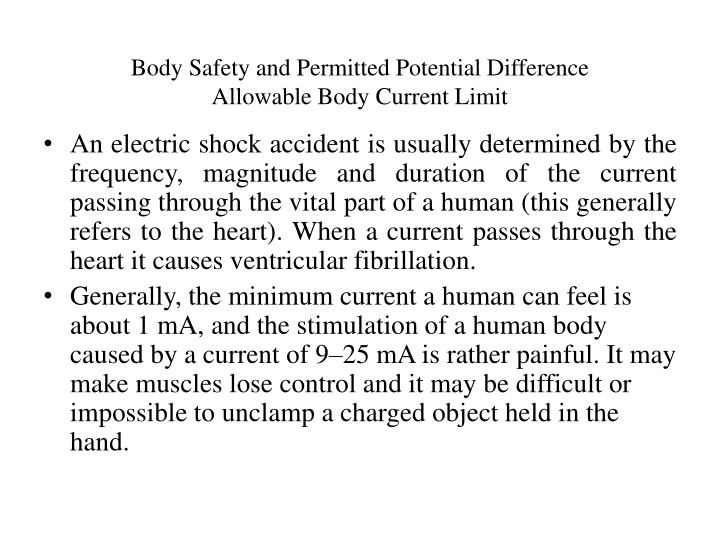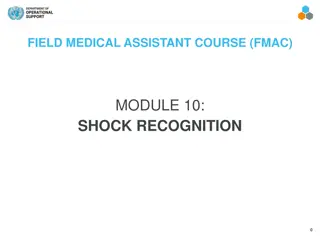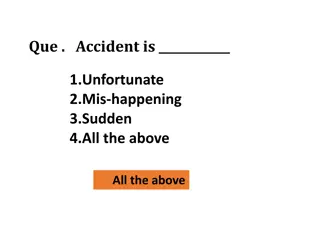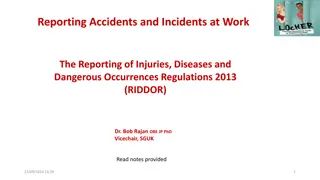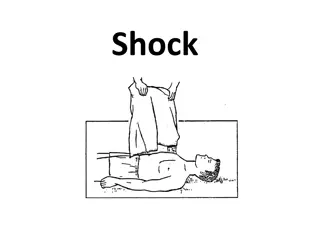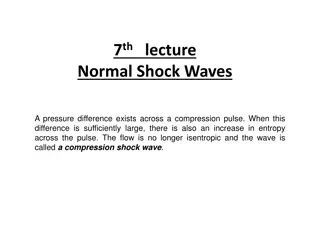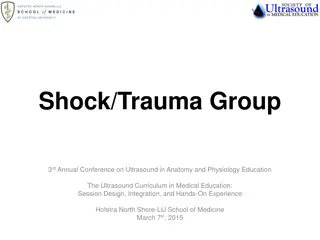Body Safety in Electric Shock Accidents
An electric shock accident's severity depends on current frequency, magnitude, and duration, with the heart being a vital target. Learn about critical currents, human response thresholds, and safety design considerations for grounding devices. Discover how energy coefficients impact allowable body current based on weight. Stay informed and prioritize safety in high-risk scenarios.
Download Presentation

Please find below an Image/Link to download the presentation.
The content on the website is provided AS IS for your information and personal use only. It may not be sold, licensed, or shared on other websites without obtaining consent from the author.If you encounter any issues during the download, it is possible that the publisher has removed the file from their server.
You are allowed to download the files provided on this website for personal or commercial use, subject to the condition that they are used lawfully. All files are the property of their respective owners.
The content on the website is provided AS IS for your information and personal use only. It may not be sold, licensed, or shared on other websites without obtaining consent from the author.
E N D
Presentation Transcript
Body Safety and Permitted Potential Difference Allowable Body Current Limit An electric shock accident is usually determined by the frequency, magnitude and duration of the current passing through the vital part of a human (this generally refers to the heart). When a current passes through the heart it causes ventricular fibrillation. Generally, the minimum current a human can feel is about 1 mA, and the stimulation of a human body caused by a current of 9 25 mAis rather painful. It may make muscles lose control and it may be difficult or impossible to unclamp a charged object held in the hand.
When the current becomes greater, heart fibrillation occurs and causes death. Therefore, the critical value of an electric shock current causing ventricular fibrillation is the main issue to be considered in the safety design of a grounding device. For an AC current with a frequency of 50 Hz, it can be classified into three categories according to human responses:
Sensory current: this is the minimum current a human can feel. For a male adult it is 1.1 mA, and for a female adult it is 0.7 mA. Extrication current: this is the maximum current that can be extricated by human after electroshock. It is also related to gender, for a male adult it is 16 mA and for a female adult it is 10.5 mA. Fatal current: this is the minimum current that threatens life in the shortest time, by causing ventricular fibrillation.
The value of the current plays a vital role in electroshock on the human body. However, when current passing through the body, the duration of the current must also be considered. According to analysis, if the duration is very short, the current that a human can tolerate and which does not cause ventricular fibrillation is: where the unit of is A; and K is an energy coefficient related to the weight of the human body.
The energy coefficients of 50 and 70 kg humans are K50= 0.0135 and K70=0.0247 , respectively. Therefore, we can get the allowable body current IK50for a 50 kg human : According to the calculation result from Equation above, the permitted current corresponding to 1 s duration is 116 mA, while that corresponding to 0.1 s is 367 mA and that corresponding to 0.05 s is 519 mA.
Allowable Body Voltage Multiplying the allowable body current IKby the body resistance RB, we can obtain the allowable body voltage USV: In a solidly grounded system, a single-phase or two-phase ground fault cannot exist for a long time, so substituting Equation current into voltage Equation, the short-time allowable body voltage for a 50 kg human is:
Also the allowable body voltage for a 70 kg human can be obtained: If we assume the body resistance RB =1000 V and t = 1 s, the allowable body voltage in 1 s for 50 and 70 kg humans are 116 and 157 V, respectively.
Allowable Potential Difference The allowable potential difference of a human body involves the touch voltage, step voltage . The step voltage is the difference in surface potential experienced by a person bridging a distance of 1 m with his two feet without contacting any other grounded object, whereas the touch voltage is the potential difference between the ground potential rise (GPR) and the surface potential at the point where a person is standing, while at the same time his hand is in contact with a grounded object.
After obtaining the allowable body current by Equations above, when the appropriate parameters of the human body are determined, we can calculate the allowable potential difference generated between the contact points.
the external current may have two parallel paths: one is the direct path through the earth, the other is through the external parallel circuit. Because the fault current is as high as several hundred to several thousand amperes, while the allowable body current must be limited to a milli ampere level, the influence of the body on the applied voltage can be neglected. We can assume that all the potential differences before the electroshock are not changed.
When one walks on the ground, the touch resistance RF between the two feet and the ground surface and the body resistance RB are connected in series, and the permissible step voltage US between the two feet is: where Vs is the potential difference between two points where no person stands.
When a person stands on the ground and contacts any grounded metal conductor, the touch resistances between the two feet and the ground are in parallel, and the actual voltage (i.e., the permissible touch voltage UT) between one hand and one foot is: where VT is the potential difference between two points where no person stands.
When the feet are in contact with the ground, the touch resistance RF between one foot and the ground surface has a strong influence on the body current. Usually, one foot is regarded as a round plate with radius b (in cm) and then, in uniform soil, RF can be calculated by: If the resistivity of the surface soil is assumed as 200 m, the body resistance as 1000 , Usually, one foot is regarded as a round plate with radius b (in cm) , IF b=8
the step voltage US and the touch voltage UT calculated by Equations above are:
